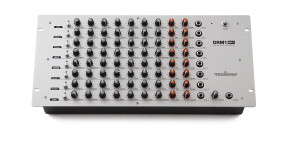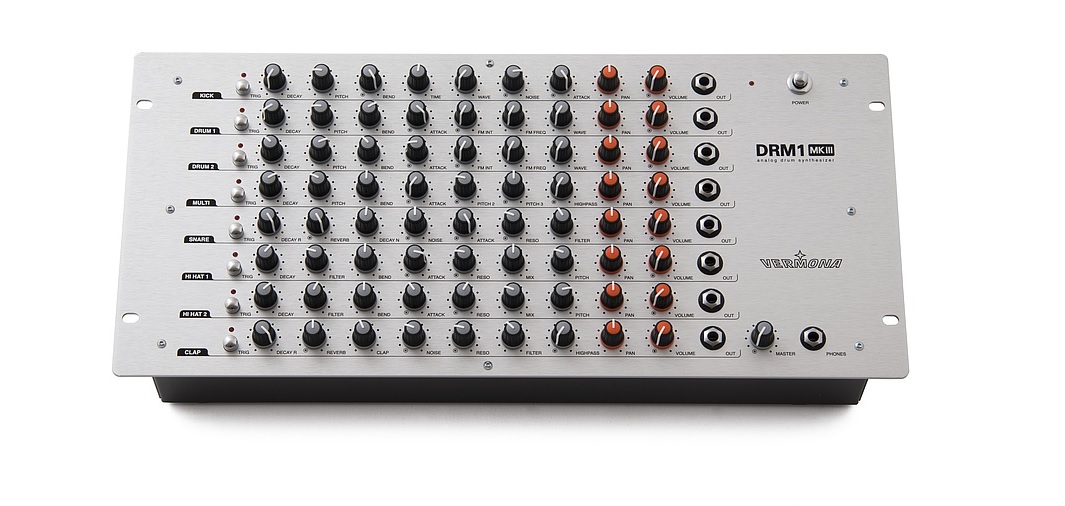Sujet DRM1 avec MIDI CC
- 3 réponses
- 2 participants
- 1 067 vues
- 2 followers
lesucre
118
Posteur·euse AFfiné·e
Premier post
1 Posté le 30/01/2020 à 10:24:28DRM1 avec MIDI CC
Bonjour,
Je sais que ma question est un peu bizarre mais je chercher un DRM1 avec midi CC, je m’explique :
J’ai eu l’occasion d’utiliser quelques temps une DRM1 MKIII et je suis tombé sous le charme de cette machine. J’adore le son de cette machine et l’interface pousse à vraiment à expérimenter.
A plusieurs occasions j’ai hésité à l’acheter mais au final le fait que les paramètres ne soient pas contrôlables en MIDI ou à défaut en CV m’a toujours dissuadé.
Au-delà de la résolution limitée du MIDI je reverrais de pouvoir la contrôler avec mon Octatrack : 8 tracks MIDI avec le super séquenceur Elektron et 12 paramètres modulables par track avec Plock etc. Rien que d’y penser j’en bave…
Sampler la DRM1 avec mon Octa n’est pas une solution dans mon cas.
Je suis donc à la recherche d’une machine (analo ou numérique peu importe) qui est le caractère d’un DRM1 (un son puissant et avec sa propre identité) et dont les paramètres sont modulables en MIDI ou à défaut en CV.
Le fait qu’elle est un séquenceur m’importe peu puisque l’idée est de la séquencer avec mon Octa.
Pareil pour les contrôles en façade, s’il n’y en pas je me bricolerais un contrôler midi si nécessaire.
Niveau budget disons que je peux aller jusqu’à 1000€.
Je sais que ma question est un peu bizarre mais je chercher un DRM1 avec midi CC, je m’explique :
J’ai eu l’occasion d’utiliser quelques temps une DRM1 MKIII et je suis tombé sous le charme de cette machine. J’adore le son de cette machine et l’interface pousse à vraiment à expérimenter.
A plusieurs occasions j’ai hésité à l’acheter mais au final le fait que les paramètres ne soient pas contrôlables en MIDI ou à défaut en CV m’a toujours dissuadé.
Au-delà de la résolution limitée du MIDI je reverrais de pouvoir la contrôler avec mon Octatrack : 8 tracks MIDI avec le super séquenceur Elektron et 12 paramètres modulables par track avec Plock etc. Rien que d’y penser j’en bave…
Sampler la DRM1 avec mon Octa n’est pas une solution dans mon cas.
Je suis donc à la recherche d’une machine (analo ou numérique peu importe) qui est le caractère d’un DRM1 (un son puissant et avec sa propre identité) et dont les paramètres sont modulables en MIDI ou à défaut en CV.
Le fait qu’elle est un séquenceur m’importe peu puisque l’idée est de la séquencer avec mon Octa.
Pareil pour les contrôles en façade, s’il n’y en pas je me bricolerais un contrôler midi si nécessaire.
Niveau budget disons que je peux aller jusqu’à 1000€.
krodelabestiole
344
Posteur·euse AFfamé·e
2 Posté le 22/11/2020 à 23:35:21
j'avais pas vu ton message avant de poster, mais je me pose exactement la même question : https://fr.audiofanzine.com/bar/vermona/drm1-mkiii/forums/t.722081,alternative-avec-midi-cv.html
tu as trouvé ton bonheur ?
pour une approche plus technique avec les mains franchement dans le cambouis il y aurait sûrement moyen de midifier chaque potard avec un arduino (qui récupère les MIDI CC depuis le MIDI IN) et :
- soit des resistances variables contrôlées électroniquement / ou vactrol - voir ici un projet de ce type :
- soit des servo moteurs / potards motorisés (ce qui risque de coûter un bras et oblige sûrement à surélever la plaque de surface, ou à repenser complètement le boîtier)
tu as trouvé ton bonheur ?
pour une approche plus technique avec les mains franchement dans le cambouis il y aurait sûrement moyen de midifier chaque potard avec un arduino (qui récupère les MIDI CC depuis le MIDI IN) et :
- soit des resistances variables contrôlées électroniquement / ou vactrol - voir ici un projet de ce type :
- soit des servo moteurs / potards motorisés (ce qui risque de coûter un bras et oblige sûrement à surélever la plaque de surface, ou à repenser complètement le boîtier)
[ Dernière édition du message le 24/11/2020 à 15:42:16 ]
krodelabestiole
344
Posteur·euse AFfamé·e
3 Posté le 24/11/2020 à 16:01:59
pas mal d'infos (en anglais) concernant des mods intéressants de la DRM1 sur la description de cette vidéo :
Citation :
Modifications overview:
====================
-Trigger in for each voice (two for each HiHat) on the front
-Main Pitch control for near each voice (no 1V/Oct its a drum synth
-Filter control for Snare and HiHat
-Sub outs from Multi (Osci 2 and 3 constant in volume)
-Sub outs from Drum 1+2 (It' the main voice with constant volume)
-Audio In for BassDrum
-Decay control via switch
-( Decay control via CV )
-Simple mixer tool on the side
Hack Notes:
===========
Just if some is interest, maybe its helpful to mod your own. It started for me as a fun project, planed for one day to install a DIY trigger board. Since it turned out that i can remove every single voice PCB easy to discover, i did some more modifications.
Trigger Inputs:
------------------------
Firts i stated with the trigger input and found some hand drawings shematic on MUFF WIGGLER. Its just just a simple trigger converter with std parts like bc546-548 10k 1k. Just give google a try or check https://www.muffwiggler.com/forum/vie.... For those no board needs to be removed. It's more plug and play and could be installed on the side of the mainboard.(i used an ic socket to connect the cables from my board to the prepared sockt row within the mainbaord) Also the backside could be used for the trigger outs, but i did it on the front. Seems more handy, when it become a part of my eurorack system.
Inside of the Vermona is a lot of space to but parts on the front. I Did on the left side for each row two std eurorack connectors from cliff ( same shape as the doepfer one) and on the right side there was space for 4 for each row except the first and the last voice (power , phone ...)
Pitch
Works like each other VCO and have a sum mix for pitch controll near the Pitch poti.(mostly the nearest LM072 -In). Follow the trace of the pitch potentiometer (to the resistoer which goes in the 072 -in) and add another to the mix in. Just add a nother resister for own cv mod.
Notes:
-The pitch works inverted. I did a std inverter befor i feed it to the mix in. (OP, 100k in, 100k feedback 100-490K to lm072 -in).
-BassDrum I did a 390K value for the mix in resistor on the lm072 -in for only sligthly pitch control.
-For all othvr Voices, I used the same value as the pitch poti ueses.(mostly a 100K).
Pitch control is far away from 1V/Oct since the internal AD signal is alsos added to the pitch control. Only works decent if Bend is in center position.
Pitch control 2 + 3 of Multi
The pitch potentiometer get a input signal and change those to a range from 8 to -9
I just broke the in conection and did a simple mixer of my cv signal and the existing and feed back to the input of the potentiometer. (top/right tip of the poti)
Filter for Snare Hihat
I broke the out of the potentimeter ( middle one ) and feed in a simple mixer with my own cv mod signal and feed back those mix out. ( Mixer = 2 std. Inverters)
Bass Drum Audio In
The LM7600 Mix all signals like an inverted mixer, i feed my signal in to the same as the others ( i guess it was a 390k) just like the noise to add a bit of character.
(I did a simple inverter before too)
Signal Outs
Grapped from the outs of LM072
Some are alwyse fixed from the volume some controled by the internal AD
Grapped on constant volume. Just with a simple inverter out, to avoid influence the impetances.(Was working for Bass Drum 1 + 2 and Multi )
Decay Mod
Near the Decay poti i found mostly a 2,2uf, with a switch i change those to ~24uf. Just simple switch to put the C in paralell. (with right polarity!).
For Basedrum i only chossed a smaler value, for Drum 1 i used 22uf to get long kind of drone sounds.I also installed decaly cv control. By shifting the ADR voltage somehow but this is still under construction.
General notes:
-------------------------
Pitch control is far away from 1V/Oct ...i searched and changed a lot
some has more some less values are from 50k to 100k, only bass i did with 390.
Mix in shematics ( simple inverter or two inverter act as mix in ) could be limited to +-8 V ( its was it internal is ) with simple zdiode
Whenever i feed some out, i did simple inverter or impetance converters
Its possible to install a smale pcb on the side and do some wires to each board.
I did all invertes and mixers flying on singe chips connected to each single board.
Its just started as fun project and was never suposed to share . Never the less some may seen this information as useful.
lesucre
118
Posteur·euse AFfiné·e
4 Posté le 24/11/2020 à 22:03:32
Merci pour le déterrage, je viens d'apprendre pas mal de choses!
Perso j'ai acheté un peu par hasard une LXR de Sonic potion d'occas et c'est une belle surprise.
Évidemment elle n'est en rien comparable à la DRM1 elle se rapproche plus d'une Machinedrum de Elektron.
Je la séquence avec mon OT avec 12 Cc par track c'est juste du pur bonheur.
Pour des drums plus analo j'utilise mon analog four. Encore une fois rien à voir avec la DRM1 mais pour l'instant je ne sens plus le besoin d'une DRM1 dans mon setup.
Pour autant les infos partagées tombe au bon moment. J'ai acheté une TD3 récemment (1er et dernier achat de matos Behringer, surtout après la copie du keystep, je ne veux pas filer du fric à une boîte comme ça...). Je suis quand même très satisfait de cette machine mis a part le manque de contrôle CV ou midi, même pas un CV pour le cutoff... J'envisage de la modder et utiliser un Arduino pour bypasser les potards et ajouter un contrôle midi à l'air super intéressant !
Perso j'ai acheté un peu par hasard une LXR de Sonic potion d'occas et c'est une belle surprise.
Évidemment elle n'est en rien comparable à la DRM1 elle se rapproche plus d'une Machinedrum de Elektron.
Je la séquence avec mon OT avec 12 Cc par track c'est juste du pur bonheur.
Pour des drums plus analo j'utilise mon analog four. Encore une fois rien à voir avec la DRM1 mais pour l'instant je ne sens plus le besoin d'une DRM1 dans mon setup.
Pour autant les infos partagées tombe au bon moment. J'ai acheté une TD3 récemment (1er et dernier achat de matos Behringer, surtout après la copie du keystep, je ne veux pas filer du fric à une boîte comme ça...). Je suis quand même très satisfait de cette machine mis a part le manque de contrôle CV ou midi, même pas un CV pour le cutoff... J'envisage de la modder et utiliser un Arduino pour bypasser les potards et ajouter un contrôle midi à l'air super intéressant !
- < Liste des sujets
- Charte



